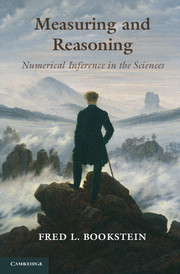Book contents
- Frontmatter
- Dedication
- Contents
- Analytical Table of Contents
- Preface
- Epigraphs
- Part I The Basic Structure of Numerical Inference
- Part II A Sampler of Strategies
- Part III Numerical Inference for General Systems
- 5 Abduction and Consilience in More complicated Systems
- 6 The Singular-Value Decomposition: A Family of Pattern Engines for Organized Systems
- 7 Morphometrics, and Other Examples
- Part IV What Is to Be Done?
- References
- Index
- Plate section
5 - Abduction and Consilience in More complicated Systems
from Part III - Numerical Inference for General Systems
Published online by Cambridge University Press: 05 March 2014
- Frontmatter
- Dedication
- Contents
- Analytical Table of Contents
- Preface
- Epigraphs
- Part I The Basic Structure of Numerical Inference
- Part II A Sampler of Strategies
- Part III Numerical Inference for General Systems
- 5 Abduction and Consilience in More complicated Systems
- 6 The Singular-Value Decomposition: A Family of Pattern Engines for Organized Systems
- 7 Morphometrics, and Other Examples
- Part IV What Is to Be Done?
- References
- Index
- Plate section
Summary
Analysis of Patterns in the Presence of Complexity
Continuing in the style of argument explored across the examples in Chapter 4, we ask: Can abduction and consilience bring us to clear and authoritative explanations even in analyses of more complex systems? Yes, sometimes they can. As in Section E4.3, we detect them via empirical constraints: when multiparameter data or summaries that could otherwise arise anywhere in their joint measurement space are restricted to a very small fraction of that manifold of possibilities – clusters, curves, etc. separated by systematic voids. Let me put off all definitions until a bit later and just present three quite different examples of what I am referring to.
The Hertzsprung-Russell Diagram
Astrophysics is unusual among the sciences: the oldest natural science yet by far the most limited in its range of observational channels. Harwit (1981) points out that any astronomical data resource, however extensive, is at root an organized list of basic facts, instrument-derived “elementary astronomical observations,” that have only seven descriptors each: the type of “carrier” (physical entity) to which the instrument is responding; the wavelength or energy of that carrier; the angular resolution, spectral resolution, and temporal resolution of the instrument; the date and time of the observation; and the direction in which the instrument was pointing (along with directionality or polarization, in some cases).
- Type
- Chapter
- Information
- Measuring and ReasoningNumerical Inference in the Sciences, pp. 291 - 345Publisher: Cambridge University PressPrint publication year: 2014
- 1
- Cited by



